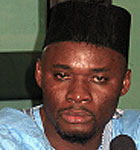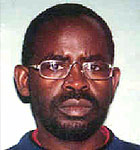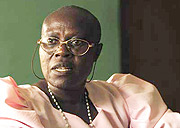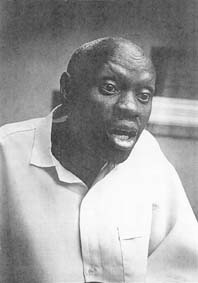
The International Criminal Tribunal for Rwanda was an international court established in November 1994 by the United Nations Security Council in Resolution 955 in order to judge people responsible for the Rwandan genocide and other serious violations of international law in Rwanda, or by Rwandan citizens in nearby states, between 1 January and 31 December 1994. The court eventually convicted 61 individuals at a cost of $1.3 billion.

The Rwandan genocide occurred between 7 April and 15 July 1994 during the Rwandan Civil War. During this period of around 100 days, members of the Tutsi minority ethnic group, as well as some moderate Hutu and Twa, were killed by armed Hutu militias. The most widely accepted scholarly estimates are around 500,000 to 662,000 Tutsi deaths.

Radio Télévision Libre des Mille Collines (RTLM) was a Rwandan radio station which broadcast from July 8, 1993 to July 31, 1994. It played a significant role in inciting the Rwandan genocide that took place from April to July 1994, and has been described by some scholars as having been a de facto arm of the Hutu government.
Simon Bikindi was a Rwandan singer-songwriter who was formerly very popular in Rwanda. His patriotic songs were playlist staples on the national radio station Radio Rwanda during the war from October 1990 to July 1994 before the Rwandan Patriotic Front took power. For actions during the Rwandan genocide, he was tried and convicted for incitement to genocide by the International Criminal Tribunal for Rwanda (ICTR) in 2008. He died of diabetes at a Beninese hospital in late 2018.
Georges Henri Yvon Joseph Ruggiu is a Belgian radio presenter who worked for Rwandan radio station Radio Télévision Libre des Mille Collines, which played a significant role in promoting the genocide against the Tutsi. Like the station's other broadcasters, Ruggiu incited violence against Tutsi and moderate Hutu over the air. He had become involved in Rwandan politics just two years before the genocide.

Hassan Ngeze is a Rwandan journalist and convicted war criminal best known for spreading anti-Tutsi propaganda and Hutu superiority through his newspaper, Kangura, which he founded in 1990. Ngeze was a founding member and leadership figure in the Coalition for the Defence of the Republic (CDR), a Rwandan Hutu Power political party that is known for helping to incite the genocide.
Félicien Kabuga is a Rwandan businessman and génocidaire who played a major role in the run-up to the Genocide of the Rwandan Tutsis. A multimillionaire, he was closely connected to dictator Juvénal Habyarimana's Hutu nationalist MRND party and the Akazu, an informal group of Hutu extremists who helped lead the Rwandan genocide.

The Impuzamugambi was a Hutu militia in Rwanda formed in 1992. Together with the Interahamwe militia, which formed earlier and had more members, the Impuzamugambi was responsible for many of the deaths of Tutsis and moderate Hutus during the Genocide against the Tutsi of 1994.

Kangura was a Kinyarwanda and French-language magazine in Rwanda that served to stoke ethnic hatred in the run-up to the Rwandan genocide. The magazine was established in 1990, following the invasion of the rebel Rwandan Patriotic Front (RPF), and continued publishing up to the genocide. Edited by Hassan Ngeze, the magazine was a response to the RPF-sponsored Kanguka, adopting a similar informal style. "Kangura" was a Rwandan word meaning "wake others up", as opposed to "Kanguka", which meant "wake up". The journal was based in Gisenyi.

Jean-Bosco Barayagwiza was a convicted Génocidiare and politician associated with the Hutu Power movement. A high-ranking civil servant, Barayagwiza served as policy director within the Ministry of Foreign Affairs at the time of the Rwandan genocide. He has been described as one of the "masterminds" of the genocide.
Ferdinand Nahimana is a Rwandan historian, who was convicted of incitement to genocide for his role in the Rwandan genocide.
Radio Muhabura was a radio station of RPF during the Rwandan Civil War from 1990 to 1994. It was created in 1991 and broadcast from Uganda. It was the first alternative to Radio Rwanda, reaching all but the south of Rwanda by mid-1992. It was recorded by the BBC starting in 1992. It promoted armed resistance to the "extremist" Rwandan government. In an October 1992 broadcast it claimed that militia forces of the government's party had "devised traps aimed at exterminating the youth." As early as January 1993, months before the RTLM went on-air, Radio Muhabura accused the Rwandan government of genocide. It routinely denied RPF involvement in civilian killings, and promoted resistance to "Hutu power", to the Habyarimana government, and desertion by the military.
Hutu Power is a racial and ethnosupremacist ideology that asserts the ethnic superiority of Hutu, often in the context of being superior to Tutsi and Twa, and that therefore they are entitled to dominate and murder these two groups and other minorities. Espoused by Hutu extremists, widespread support for the ideology led to the 1994 Rwandan genocide against the Tutsi and moderate Hutu who opposed the killings. Hutu Power political parties and movements included the Akazu, the Coalition for the Defence of the Republic and its Impuzamugambi paramilitary militia, and the governing National Republican Movement for Democracy and Development and its Interahamwe paramilitary militia. The theory of Hutu people being superior is most common in Rwanda and Burundi, where they make up the majority of the population. Due to its sheer destructiveness, the ideology has been compared to historical Nazism in the Western world.
Thomas Kamilindi, author of Journalism in a Time of Hate Media, describes hate media as a form of violence, which helps to demonize and stigmatize people that belong to different groups. This type of media has had an influential role in the incitement of genocide, with its most infamous cases perhaps being Radio Televizija Srbije during wars in Yugoslavia, Radio Télévision Libre des Milles Collines (RTLM) during the Rwandan genocide and Nazi Germany’s Der Stürmer.

Valérie Bemeriki is a Rwandan convicted war criminal and radio entertainer. Bemeriki was one of the main animatrices of Radio Télévision Libre des Mille Collines (RTLM), which played a significant role in promoting the genocide against the Tutsi.

Noël (Noheli) Hitimana was a presenter (animateur) on the Rwandan radio station Radio Télévision Libre des Mille Collines (RTLM), which played a significant role in promoting the genocide against the Tutsi. Like the station's other broadcasters, Hitimana incited violence against Tutsi on the air.
Violence during the Rwandan genocide of 1994 took a gender-specific form when, over the course of 100 days, up to half a million women and children were raped, sexually mutilated, or murdered. The International Criminal Tribunal for Rwanda (ICTR) handed down the first conviction for the use of rape as a weapon of war during the civil conflict, and, because the intent of the mass violence against Rwandan women and children was to destroy, in whole or in part, a particular ethnic group, it was the first time that mass rape during wartime was found to be an act of genocidal rape.
Ananie Nkurunziza born 1950s was a presenter (animateur) on the Rwandan radio station Radio Télévision Libre des Mille Collines, which played a significant role in promoting the Rwandan genocide. Like the station's other broadcasters, Nkurunziza incited violence against Tutsi and moderate Hutu on the air.

Incitement to genocide is a crime under international law which prohibits inciting (encouraging) the commission of genocide. An extreme form of hate speech, incitement to genocide is considered an inchoate offense and is theoretically subject to prosecution even if genocide does not occur, although charges have never been brought in an international court without mass violence having occurred. "Direct and public incitement to commit genocide" was forbidden by the Genocide Convention in 1948. Incitement to genocide is often cloaked in metaphor and euphemism and may take many forms beyond direct advocacy, including dehumanization and "accusation in a mirror". Historically, incitement to genocide has played a significant role in the commission of genocide, including the Armenian genocide, the Holocaust and the Rwandan genocide.
Accusation in a mirror (AiM), mirror politics, mirror propaganda, mirror image propaganda, or mirror argument is a hate-speech incitement technique. AiM refers to falsely imputing to one's adversaries the intentions that one has for oneself and/or the action that one is in the process of enacting.








